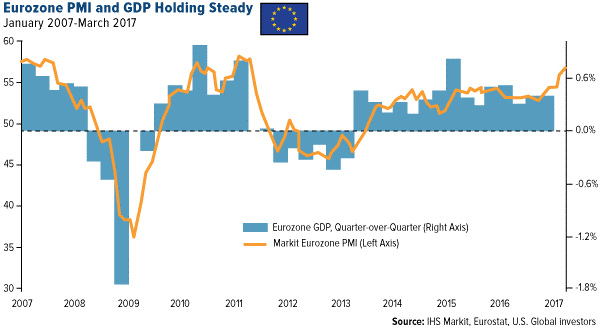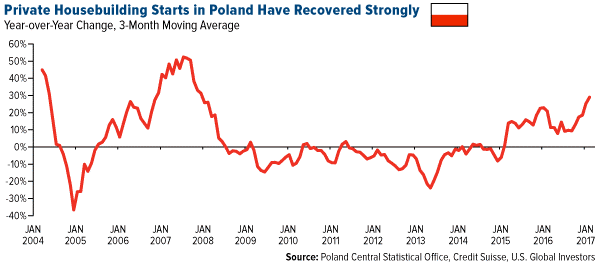7 Reasons To Be Bullish On Emerging Europe

1.Eurozone PMI at a Six-Year High
For the month of March, the preliminary purchasing manager’s index (PMI) for the eurozone reached 56.7, its highest reading since April 2011. Significant gains were made in new work and backlogs of work, employment and service sector job creation.

2.European Economic Sentiment Holding Above Its Long-Term Average
For the month of February, the Economic Sentiment Indicator (ESI)—which measures industrial confidence, services confidence, consumer confidence, construction confidence and retail trade confidence—posted a score of 108, safely above its 26-year average of 100.

3.Emerging Europe Manufacturing: Full Speed Ahead
When Western Europe is performing well, Eastern Europe typically benefits by proxy, as the latter exports to the West. With a thriving manufacturing industry that’s attracted top international corporations such as Mercedes-Benz, GM, Audi, Bosch, Lego and Nestlé, just to name a few, Hungary led all others in February, posting a PMI of 59.5.

4.The Migration Crisis Has Abated
Mediterranean sea arrivals into Europe have fallen to 2,731 a month, from a high of 220,000 in October 2015. This is important because concerns of immigration and terrorism have largely driven recent secessionist and anti-European Union sentiment, most notably among far-right hopefuls such as the Netherlands’ Geert Wilders and France’s Marie Le Pen.

5.Trump and OPEC May Have Helped Russian Stocks
The election of President Donald Trump, who has repeatedly praised Russia and its leader Vladimir Putin, as well as crude oil production cuts by the Organization of Petroleum Exporting Countries (OPEC), may have helped Russian stocks shrug off recent declines in the price of Brent oil. With the country coming out of recession, BCA Research just overweighted Russian equities, the ruble and credit relative to other emerging European states.

6.Poland Making Good on Promise to Support Families
The Polish economy has lately benefited from increased social spending and wage hikes. The government delivered on its Family 500+ program, giving each family with more than one child 500 PLN ($130) per child per month. This has doubled some families’ disposable incomes and led to a recent surge in new private housebuilding starts. What’s more, Poland is currently experiencing a baby boom, which should support economic growth in the years to come.

7.Attractive Valuations
Finally, European stocks look very attractive compared to U.S. stocks, down slightly more than one standard deviation. This should be especially enticing for investors who believe American stocks are too expensive right now.

EXPLORE INVESTMENT OPPORTUNITIES IN EMERGING EUROPE!
All opinions expressed and data provided are subject to change without notice. Some of these opinions may not be appropriate to every investor.
The Purchasing Managers' Index (PMI) is an indicator of the economic health of the manufacturing sector. The PMI is based on five major indicators: new orders, inventory levels, production, supplier deliveries and the employment environment.
The Economic Sentiment Indicator (ESI) is a composite indicator made up of five sectoral confidence indicators with different weights: Industrial confidence indicator, Services confidence indicator, Consumer confidence indicator, Construction confidence indicator Retail trade confidence indicator. The economic sentiment indicator (ESI) is calculated as an index with mean value of 100 and standard deviation of 10 over a fixed standardized sample period.
The MSCI Russia Index is designed to measure the performance of the large and mid-cap segments of the Russian market. With 21 constituents, the index covers approximately 85% of the free float-adjusted market capitalization in Russia.
The MSCI Europe Index is a free float-adjusted market capitalization index that is designed to measure developed market equity performance in Europe. As of September 2002, the MSCI Europe Index consisted of the following 16 developed market country indices: Austria, Belgium, Denmark, Finland, France, Germany, Greece, Ireland, Italy, the Netherlands, Norway, Portugal, Spain, Sweden, Switzerland, and the United Kingdom.
The S&P 500 Stock Index is a widely recognized capitalization-weighted index of 500 common stock prices in U.S. companies.
The Shiller PE ratio, also known as the P/E 10 ratio, is a valuation measure, generally applied to broad equity indices, that uses real per-share earnings over a 10-year period.
Standard deviation is a measure of the dispersion of a set of data from its mean. The more spread apart the data, the higher the deviation. Standard deviation is also known as historical volatility.
Holdings may change daily. Holdings are reported as of the most recent quarter-end. None of the securities mentioned in the article were held by any accounts managed by U.S. Global Investors as of 12/31/2016.
U.S. Global Investors, Inc. is an investment adviser registered with the Securities and Exchange Commission ("SEC"). This does not mean that we are sponsored, recommended, or approved by the SEC, or that our abilities or qualifications in any respect have been passed upon by the SEC or any officer of the SEC.
This commentary should not be considered a solicitation or offering of any investment product.
Certain materials in this commentary may contain dated information. The information provided was current at the time of publication.
Courtesy of http://usfunds.com/






 Frank Holmes is the CEO and Chief Investment Officer of
Frank Holmes is the CEO and Chief Investment Officer of 










